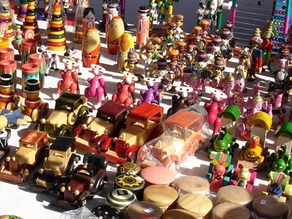5 Traditional Toy and Craft Communities in India to Support Post the Chinese Ban

If you’ve been following the news, you’ll have heard about the discouragement of Chinese toys being placed by the Indian Government. Although not an official ban, India has made it virtually impossible for Indian importers to import Chinese toys by subsequently placing a stringent standard procedure that will demand a certain quality from Chinese toys – that more than 90% of Chinese toy producers will not be able to meet – along with a hiked 60% import tax on toys from China. India’s toy market is heavily dependent on its Chinese counterpart, with it being the largest toy importer from China (an estimated 70% of total toy exports by China are to India) and suffice to say, the Modi government’s latest reform against China over recent tensions will certainly hit the country hard, especially after the many bans and hikes placed in the past few months on Chinese products, of which we are very dependent on. What will it take for this recent hit back to be successful? A number of things, chief amongst which is the problem of supply and demand within India. Most toys in a majority of toy shops across India are Chinese made, with a small portion of traditional and miscellaneous toys being Indian made. Although Indian producers and handicraft communities have a headstart due to a major fall in demand (to around 10% of what it used to be) because of COVID-19, there is still a gap that needs to be filled as quickly as possible – Indian production of mass-made toys needs to be boosted, along with the encouragement of traditionally crafted toys. Here are 5 communities to support when you travel around India – these are all forms of crafts and arts that are facing extinction as they don’t provide the variety of toys usually demanded by customers, and the intricacies Chinese toys offer. 1) Channapatna Toys Made in: Channapatna, Karnataka, available at highway shops, toy stores, handicraft stores across Karnataka The beautiful range and variety in Channapatna craftsmanship Channapatna in the region of Ramanagara, Karnataka, is a town in South India known for its large but currently dwindling community of wooden toy crafters. The town is an attraction on the road from Bangalore to Mysore and called ‘town of toys’ in Kannada too. The crafters use mostly Milkwood and Ivory wood for the toys and eco-friendly dies as well which don’t harm children. The art form of Channapatna is said to have originated from Persia as the famous carving style and work on wood was revered and brought down to India through the Persian crafters. Channapatna style includes a variety of small and large toys, cooking utensils, miniature sets, even bags/bangles. The use of a pliable and well-structured wood makes it easier for handicrafts to make a variety of shapes and implements, although the skill is very hard to establish and perfect. Check out this amazing collection of stunning pictures of the art taken by Travel and Photography which will convince you to visit the town and see its craft! This art form was heavily affected by the pandemic as crafters are dependent on roadside toy shops and tourists across the state that halted suddenly. You can support these artists very easily if you’re located in Karnataka – just drive to your nearest highway/Kamat hotel, and you’ll find a variety of them on display. Buying these low-cost trinkets can go a long way to improve your living spaces, and bring livelihood to the crafters struggling due to the pandemic. 2) Rajasthani Puppets Made in: Mainly Jodhpur and Jaipur, Bhatt community, Rajasthan Rajasthani puppet makers use local softwoods, paint, and cloth for these colourful pieces of art The string puppets of Rajasthan are famous as ‘kathputhlis’ in the local language and the main cities where they are prepared are Jaipur and Jodhpur. The Bhatt community makes these puppets as well as performs with them, a traditional art form that has been prominent for many decades. India is one of the oldest civilizations in the world, also one of the first to start crafting and creating toys/implements and trinkets close to them: many existing techniques originate from Rajasthan, where the craft of puppets and dolls is highly respected. These puppets are usually made from traditional and natural cloth and dyes available within the state, and the shows are performed by the traveling Bhatt community. When you travel to Rajasthan, especially within the popular cities of Jodhpur and Jaipur, you’ll very likely spot these puppet shops and their crafters. Buy the dolls for a very additional flair to your space or for children, or even support the Bhatt community by witnessing a puppet show authentically in Rajasthan. The Third Eye Traveler has a great blog on exploring Rajasthan, on which basis you can plan your safe visit and explore this traditional craft. 3) Pachisi/Chausar Made in: parts of Mysore, North India, available online Pachisi is a fascinating and aesthetic ancient board game Pachisi is one of the many traditional Indian board games that are slowly being driven to extinction with the advent of mass production and variety demanded within a large range of toys. The board game, constructed of local textiles and marked with embroidery done by crafters, is a very important part of India’s history – the Mughals enjoyed the game tremendously, and multiple kings and dynasties are known to have hosted the game in their parlors. It is now not as widely known, particularly by the current generation due to modern changes in the industry. There are a few startups concentrating on reviving the Indian handicrafts and arts, based in multiple cities across India that are producing and employing communities for the crafting of this board game, but largely it is still relatively unknown. These board games, like Pachisi, Bhag Chal, Chauka Bara, and Pallunguli, all traditional and ages-old, crafted by

